Glutamate Receptor-like (GLR) Family in Brassica napus: Genome-Wide Identification and Functional Analysis in Resistance to Sclerotinia sclerotiorum
Abstract
:1. Introduction
2. Results
2.1. Identification of GLR Family in Oilseed Rape
2.2. Phylogeny of BnGLR and AtGLR Families
2.3. Conserved Motifs of BnGLR Proteins
2.4. Domains and Gene Structures of BnGLRs
2.5. Cis-Acting Elements in Promoters of BnGLR Genes
2.6. Tertiary Structure of BnGLR Proteins
2.7. Amino Acid Ligands for BnGLRs
2.8. Post-Translational Modification Sites in BnGLRs
2.8.1. Phosphorylation
2.8.2. Glycosylation
2.8.3. Sumoylation
2.8.4. Methylation
2.9. Response of BnGLRs to the Pathogen Sclerotinia sclerotiorum
2.10. Silencing of BnGLR12, BnGLR35, and BnGLR53 Distinctly Altered Oilseed Rape Resistance against S. sclerotiorum
2.11. Arabidopsis Mutants of BnGLR Orthologs Exhibited Altered Plant Resistance against S. sclerotiorum
3. Discussion
4. Materials and Methods
4.1. Identification of BnGLR Proteins
4.2. Construction of BnGLR Phylogenic Tree
4.3. Identification of Motifs, Domains, and Gene Structure
4.4. Prediction of Subcellular Localization of BnGLRs
4.5. Promoter Profiling of BnGLRs
4.6. Prediction of Tertiary Protein Structure of BnGLRs
4.7. Prediction of Amino Acid Ligands Interacting with BnGLR Proteins
4.8. Post-Translational Modifications in BnGLR Proteins
4.9. Plant Materials and Pathogen Inoculation Analysis
4.10. Gene Expression Analysis
4.11. Cabbage Leaf Curl Virus (CaLCuV)-Induced Gene Silencing Manipulation Procedure
4.12. ROS Detection
4.13. Statistical Analysis
5. Conclusions
Supplementary Materials
Author Contributions
Funding
Institutional Review Board Statement
Informed Consent Statement
Data Availability Statement
Acknowledgments
Conflicts of Interest
References
- Naz, R.; Khan, A. An insight into animal glutamate receptors homolog of Arabidopsis thaliana and their potential applications-a review. Plants 2022, 19, 2580. [Google Scholar] [CrossRef] [PubMed]
- Iwano, M.; Ito, K.; Fujii, S.; Kakita, M.; Asano-Shimosato, H.; Igarashi, M.; Kaothien-Nakayama, P.; Entani, T.; Kanatani, A.; Takehisa, M.; et al. Calcium signalling mediates self-incompatibility response in the Brassicaceae. Nat. Plants 2015, 1, 15128. [Google Scholar] [CrossRef] [PubMed]
- Shoshan-Barmatz, V.; De, S. Mitochondrial VDAC, the Na+/Ca2+ exchanger, and the Ca2+ uniporter in Ca2+ dynamics and signaling. Adv. Exp. Med. Biol. 2017, 981, 323–347. [Google Scholar] [PubMed]
- Forde, B.G.; Roberts, M.R. Glutamate receptor-like channels in plants: A role as amino acid sensors in plant defence? Prime Rep. 2014, 6, 37. [Google Scholar] [CrossRef] [PubMed]
- Shi, Y.; Zeng, W.; Xu, M.; Li, H.; Zhang, F.; Chen, Z.; Anicet, G.; Huang, S.; Huang, Y.; Wang, X. Comprehensive analysis of glutamate receptor-like genes in rice (Oryza sativa L.): Genome-wide identification, characteristics, evolution, chromatin accessibility, gcHap diversity, population variation and expression analysis. Curr. Issues Mol. Biol. 2022, 44, 6404–6427. [Google Scholar] [CrossRef] [PubMed]
- Zhang, J.; Cui, T.; Su, Y.; Zang, S.; Zhao, Z.; Zhang, C.; Zou, W.; Chen, Y.; Cao, Y.; Chen, Y. Genome-wide identification, characterization, and expression analysis of glutamate receptor-like gene (GLR) family in sugarcane. Plants 2022, 11, 2440. [Google Scholar] [CrossRef] [PubMed]
- Yin, L.; Liu, S.; Sun, W.; Ke, X.; Zuo, Y. Genome-wide identification of glutamate receptor genes in adzuki bean and the roles of these genes in light and rust fungal response. Gene 2023, 879, 147593. [Google Scholar] [CrossRef] [PubMed]
- Saand, M.A.; Xu, Y.P.; Li, W.; Wang, J.P.; Cai, X.Z. Cyclic nucleotide gated channel gene family in tomato: Genome-wide identification and functional analyses in disease resistance. Front. Plant Sci. 2015, 6, 303. [Google Scholar] [CrossRef]
- Chen, J.; Jing, Y.; Zhang, X.; Li, L.; Wang, P.; Zhang, S.; Zhou, H.; Wu, J. Evolutionary and expression analysis provides evidence for the plant glutamate-like receptors family is involved in woody growth-related function. Sci. Rep. 2016, 6, 32013. [Google Scholar] [CrossRef]
- Luo, B.; Zhang, H.; Li, D.; Wu, Q.; Ge, W.; Zhu, T.; Chen, Y.; Huang, Y.; Lin, Y.; Lai, Z. Genome-wide identification of the banana GLR gene family and its expression analysis in response to low temperature and abscisic acid/methyl jasmonate. Sheng Wu Gong Cheng Xue Bao 2023, 39, 2874–2896. [Google Scholar]
- Yang, L.; Zhao, Y.; Wu, X.; Zhang, Y.; Fu, Y.; Duan, Q.; Ma, W.; Huang, J. Genome-wide identification and expression analysis of BraGLRs reveal their potential roles in abiotic stress tolerance and sexual reproduction. Cells 2022, 11, 3729. [Google Scholar] [CrossRef] [PubMed]
- Kang, S.; Kim, H.B.; Lee, H.; Choi, J.Y.; Heu, S.; Oh, C.J.; Kwon, S.I.; An, C.S. Overexpression in Arabidopsis of a plasma membrane-targeting glutamate receptor from small radish increases glutamate-mediated Ca2+ Influx and delays fungal infection. Mol. Cells 2006, 21, 418–427. [Google Scholar] [CrossRef]
- Li, X.; Zhu, T.; Wang, X.; Zhu, M. Genome-wide identification of glutamate receptor-like gene family in soybean. Heliyon 2023, 9, e21655. [Google Scholar] [CrossRef]
- Roy, B.C.; Shukla, N.; Gachhui, R.; Mukherjee, A. Genome-wide analysis of glutamate receptor gene family in allopolyploid Brassica napus and its diploid progenitors. Genetica 2023, 151, 293–310. [Google Scholar] [CrossRef] [PubMed]
- Grenzi, M.; Bonza, M.C. Structural insights into long-distance signal transduction pathways mediated by plant glutamate receptor-like channels. New Phytol. 2021, 229, 1261–1267. [Google Scholar] [CrossRef] [PubMed]
- Alfieri, A.; Doccula, F.G. The structural bases for agonist diversity in an Arabidopsis thaliana glutamate receptor-like channel. Proc. Natl. Acad. Sci. USA 2020, 117, 752–760. [Google Scholar] [CrossRef] [PubMed]
- Grenzi, M.; Bonza, M.C.; Costa, A. Signaling by plant glutamate receptor-like channels: What else! Curr. Opin. Plant Biol. 2022, 68, 102253. [Google Scholar] [CrossRef] [PubMed]
- Reddy, A.S.; Ali, G.S.; Celesnik, H.; Day, I.S. Coping with stresses: Roles of calcium-and calcium/calmodulin-regulated gene expression. Plant Cell 2011, 23, 2010–2032. [Google Scholar] [CrossRef] [PubMed]
- Kong, D.; Hu, H.C.; Okuma, E.; Lee, Y.; Lee, H.S.; Munemasa, S.; Cho, D.; Ju, C.; Pedoeim, L.; Rodriguez, B. L-Met activates AtGLR Ca2+ channels upstream of ROS production and regulates stomatal movement. Cell Rep. 2016, 17, 2553–2561. [Google Scholar] [CrossRef]
- Wang, Y.; Yu, D.; Zhao, H.; Jiang, L.; Gao, L.; Song, Y.; Liu, Z.; Bao, F.; Hou, C.; He, Y. A glutamate receptor-like gene is involved in ABA-mediated growth control in Physcomitrium patens. Plant Signal Behav. 2022, 17, 2145057. [Google Scholar] [CrossRef]
- Yu, B.; Wu, Q.; Li, X.; Zeng, R.; Min, Q.; Huang, J. Glutamate receptor-like gene OsGLR3.4 is required for plant growth and systemic wound signaling in rice (Oryza sativa). New Phytol. 2022, 233, 1238–1256. [Google Scholar] [CrossRef] [PubMed]
- Meyerhoff, O.; Müller, K.; Roelfsema, M.R.; Latz, A.; Lacombe, B.; Hedrich, R.; Dietrich, P.; Becker, D. AtGLR3.4, a glutamate receptor channel-like gene is sensitive to touch and cold. Planta 2005, 222, 418–427. [Google Scholar] [CrossRef] [PubMed]
- Cheng, Y.; Zhang, X.; Sun, T.; Tian, Q.; Zhang, W.-H. Glutamate receptor homolog AtGLR3.4 is involved in regulation of seed germination under salt stress in Arabidopsis. Plant Cell Physiol. 2018, 59, 978–988. [Google Scholar] [CrossRef] [PubMed]
- Manzoor, H.; Kelloniemi, J.; Chiltz, A.; Wendehenne, D.; Pugin, A.; Poinssot, B.; Garcia-Brugger, A. Involvement of the glutamate receptor AtGLR3.3 in plant defense signaling and resistance to Hyaloperonospora arabidopsidis. Plant J. 2013, 76, 466–480. [Google Scholar] [CrossRef] [PubMed]
- Feng, S.; Pan, C.; Ding, S.; Ma, Q.; Hu, C.; Wang, P.; Shi, K. The glutamate receptor plays a role in defense against Botrytis cinerea through electrical signaling in tomato. Appl. Sci. 2021, 11, 11217. [Google Scholar] [CrossRef]
- Li, F.; Wang, J.; Ma, C.; Zhao, Y.; Wang, Y.; Hasi, A.; Qi, Z. Glutamate receptor-like channel AtGLR3.3 is involved in mediating glutathione-triggered cytosolic calcium transients, transcriptional changes, and innate immunity responses in Arabidopsis. Plant Physiol. 2013, 162, 1497–1509. [Google Scholar] [CrossRef] [PubMed]
- Roy, B.C.; Mukherjee, A. Computational analysis of the glutamate receptor gene family of Arabidopsis thaliana. J. Biomol. Struct. Dyn. 2017, 35, 2454–2474. [Google Scholar] [CrossRef] [PubMed]
- Bailey, T.L.; Johnson, J.; Grant, C.E.; Noble, W.S. The MEME suite. Nucleic Acids Res. 2015, 43, W39–W49. [Google Scholar] [CrossRef]
- Chen, C.; Wu, Y.; Li, J.; Wang, X.; Zeng, Z.; Xu, J.; Liu, Y.; Feng, J.; Chen, H.; He, Y.; et al. TBtools-II: A "one for all, all for one" bioinformatics platform for biological big-data mining. Mol. Plant 2023, 16, 1733–1742. [Google Scholar] [CrossRef]
- Ali, E.; Saand, M.A.; Khan, A.R.; Shah, J.M.; Feng, S.; Ming, C.; Sun, P. Genome-wide identification and expression analysis of detoxification efflux carriers (DTX) genes family under abiotic stresses in flax. Plant Physiol. 2021, 171, 483–501. [Google Scholar] [CrossRef]
- Rahman, H.; Xu, Y.P.; Zhang, X.R.; Cai, X.Z. Brassica napus genome possesses extraordinary high number of CAMTA genes and CAMTA3 contributes to PAMP triggered immunity and resistance to Sclerotinia sclerotiorum. Front. Plant Sci. 2016, 7, 581. [Google Scholar] [CrossRef] [PubMed]
- Silamparasan, D.; Chang, I.F.; Jinn, T.L. Calcium-dependent protein kinase CDPK16 phosphorylates serine-856 of glutamate receptor-like AtGLR3.6 protein leading to salt-responsive root growth in Arabidopsis. Front. Plant Sci. 2023, 14, 1093472. [Google Scholar] [CrossRef] [PubMed]
- Wang, P.H.; Lee, C.E.; Lin, Y.S.; Lee, M.H.; Chen, P.Y.; Chang, H.C.; Chang, I.F. The glutamate receptor-like protein GLR3.7 interacts with 14-3-3ω and participates in salt stress response in Arabidopsis thaliana. Front. Plant Sci. 2019, 10, 1169. [Google Scholar] [CrossRef] [PubMed]
- Johnson, J.M.; Ludwig, A.; Furch, A.C.U.; Mithöfer, A.; Scholz, S. The beneficial root-colonizing fungus Mortierella hyalina promotes the aerial growth of Arabidopsis and activates calcium-dependent responses that restrict Alternaria brassicae-induced disease development in roots. Mol. Plant Microbe Interact. 2019, 32, 351–363. [Google Scholar] [CrossRef]
- Khan, M.S.I.; Gao, X.; Liang, K.; Mei, S.; Zhan, J. Virulent drexlervirial bacteriophage MSK, morphological and genome resemblance with Rtp bacteriophage inhibits the multidrug-resistant bacteria. Front. Microbiol. 2021, 12, 706700. [Google Scholar] [CrossRef] [PubMed]
- He, Y.H.; Zhang, Z.R.; Xu, Y.P.; Chen, S.Y.; Cai, X.Z. Genome-wide identification of rapid alkalinization factor family in Brassica napus and functional analysis of BnRALF10 in immunity to Sclerotinia sclerotiorum. Front. Plant Sci. 2022, 13, 877404. [Google Scholar] [CrossRef] [PubMed]
- Letunic, I.; Bork, P. 20 years of the SMART protein domain annotation resource. Nucleic Acids Res. 2017, 46, D493–D496. [Google Scholar] [CrossRef] [PubMed]
- Wang, J.; Chitsaz, F.; Derbyshire, M.K.; Gonzales, N.R.; Gwadz, M.; Lu, S.; Marchler, G.H.; Song, J.S.; Thanki, N.; Yamashita, R.A. The conserved domain database in 2023. Nucleic Acids Res 2023, 51, D384–D388. [Google Scholar] [CrossRef] [PubMed]
- Hu, B.; Jin, J.; Guo, A.Y.; Zhang, H.; Luo, J.; Gao, G. GSDS 2.0: An upgraded gene feature visualization server. Bioinformatics 2015, 31, 1296–1297. [Google Scholar] [CrossRef]
- Kakar, K.U.; Nawaz, Z.; Kakar, K.; Ali, E.; Almoneafy, A.A.; Ullah, R.; Ren, X.L.; Shu, Q.Y. Comprehensive genomic analysis of the CNGC gene family in Brassica oleracea: Novel insights into synteny, structures, and transcript profiles. BMC Genom. 2017, 18, 869. [Google Scholar] [CrossRef]
- Sympli, H.D. Estimation of drug-likeness properties of GC–MS separated bioactive compounds in rare medicinal Pleione maculata using molecular docking technique and Swiss ADME in silico tools. Netw. Model. Anal. Health Inform. Bioinform. 2021, 10, 1–36. [Google Scholar] [CrossRef] [PubMed]
- Laskowski, R.A.; Swindells, M.B. LigPlot+: Multiple ligand–protein interaction diagrams for drug discovery. J. Chem. Inf. Model. 2011, 51, 2778–2786. [Google Scholar] [CrossRef] [PubMed]
- Baloch, A.A.; Raza, A.M.; Rana, S.S.A.; Ullah, S.; Khan, S.; Zahid, H.; Malghani, G.K.; Kakar, K.U. BrCNGC gene family in field mustard: Genome-wide identification, characterization, comparative synteny, evolution and expression profiling. Sci. Rep. 2021, 11, 24203. [Google Scholar] [CrossRef] [PubMed]
- He, Y.H.; Chen, S.Y.; Chen, X.Y.; Xu, Y.P.; Liang, Y.; Cai, X.Z. RALF22 promotes plant immunity and amplifies the Pep3 immune signal. J. Integr. Plant Biol. 2023, 65, 2519–2534. [Google Scholar] [CrossRef]
- Cao, J.Y.; Xu, Y.P.; Cai, X.Z. TMT-based quantitative proteomics analyses reveal novel defense mechanisms of Brassica napus against the devastating necrotrophic pathogen Sclerotinia sclerotiorum. J. Proteom. 2016, 143, 265–277. [Google Scholar] [CrossRef]
- Xiao, Z.; Xing, M.; Liu, X.; Fang, Z.; Yang, L.; Zhang, Y.; Wang, Y.; Zhuang, M.; Lv, H. An efficient virus-induced gene silencing (VIGS) system for functional genomics in Brassica using a cabbage leaf curl virus (CaLCuV)-based vector. Planta 2020, 252, 42. [Google Scholar] [CrossRef]

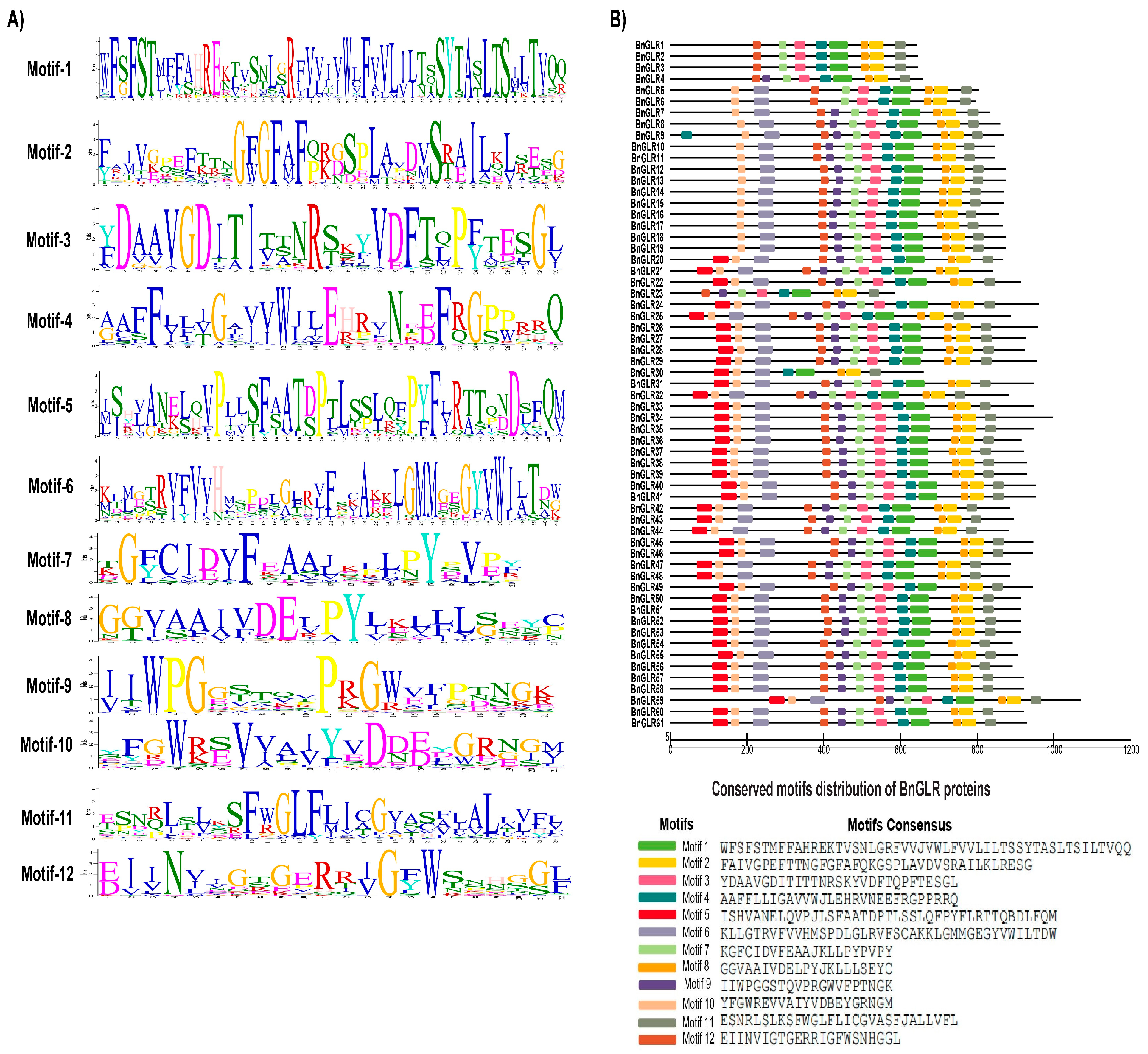


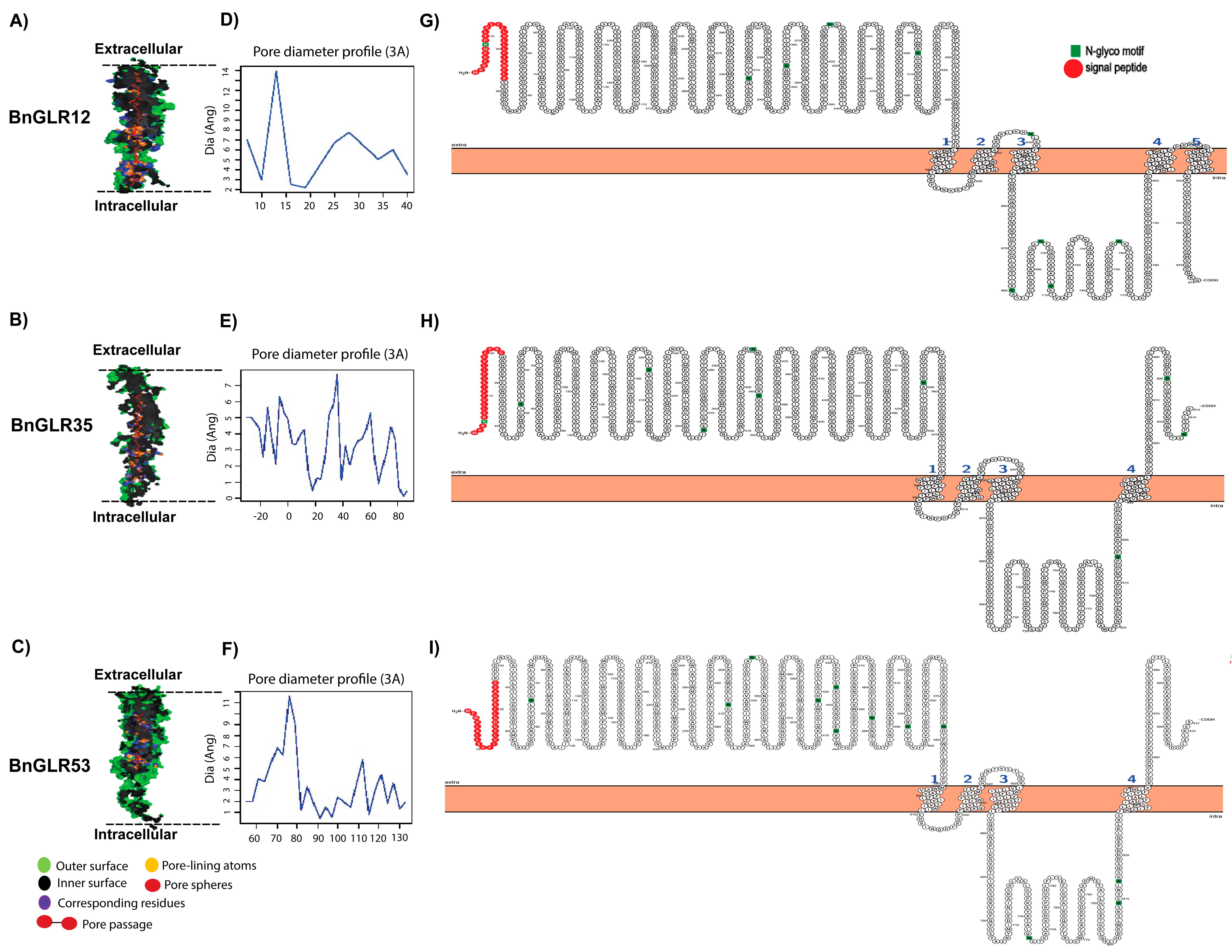
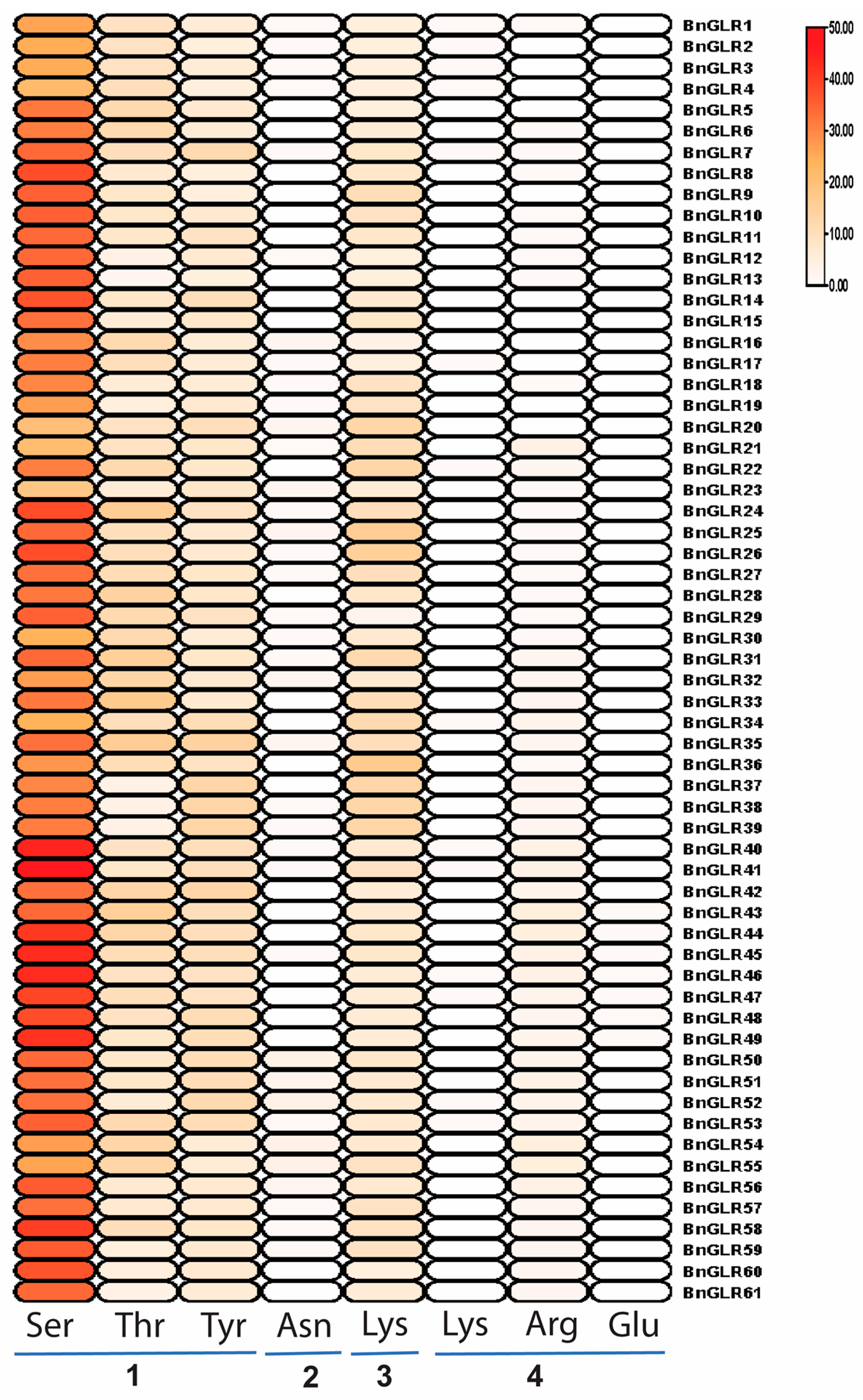
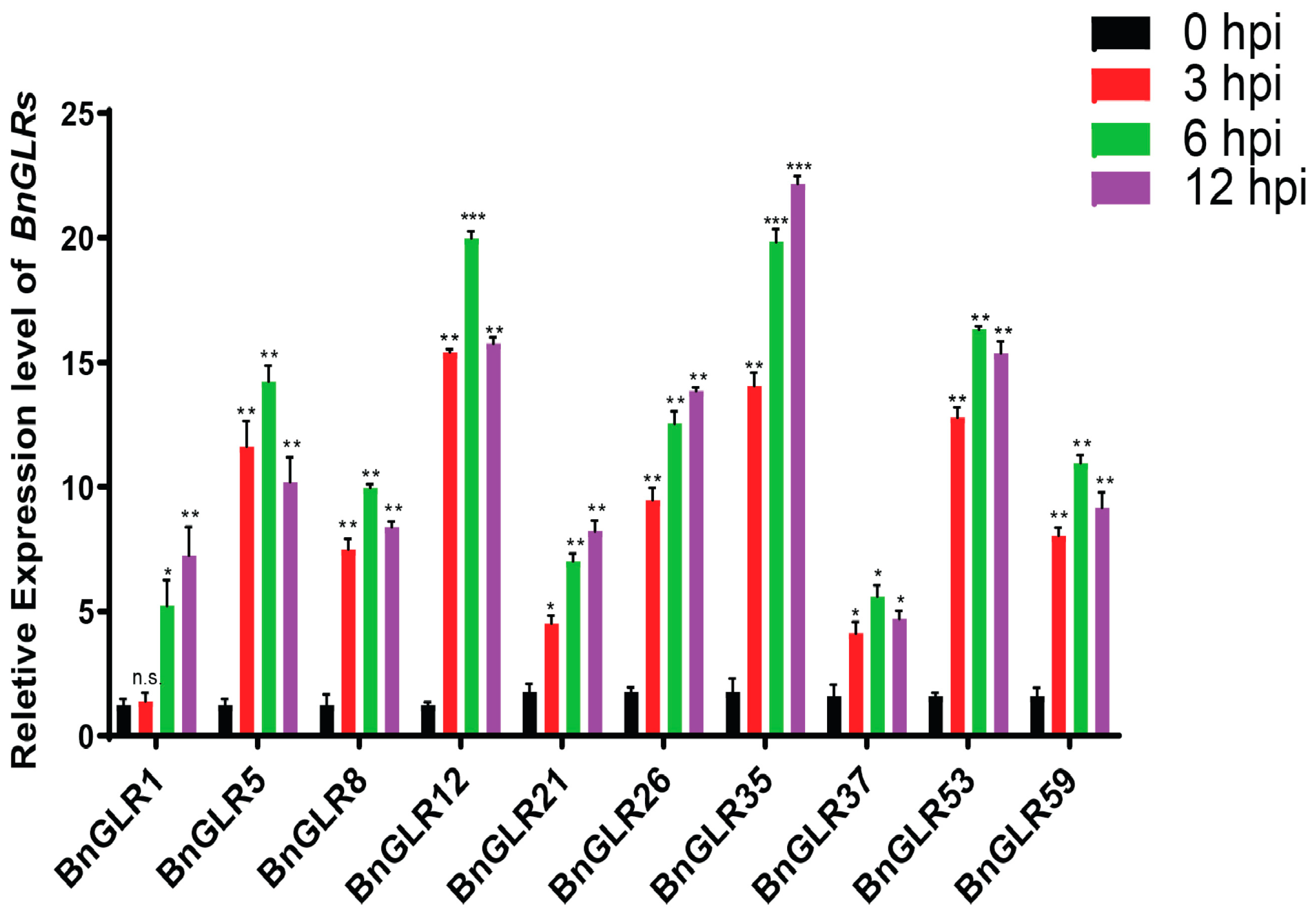

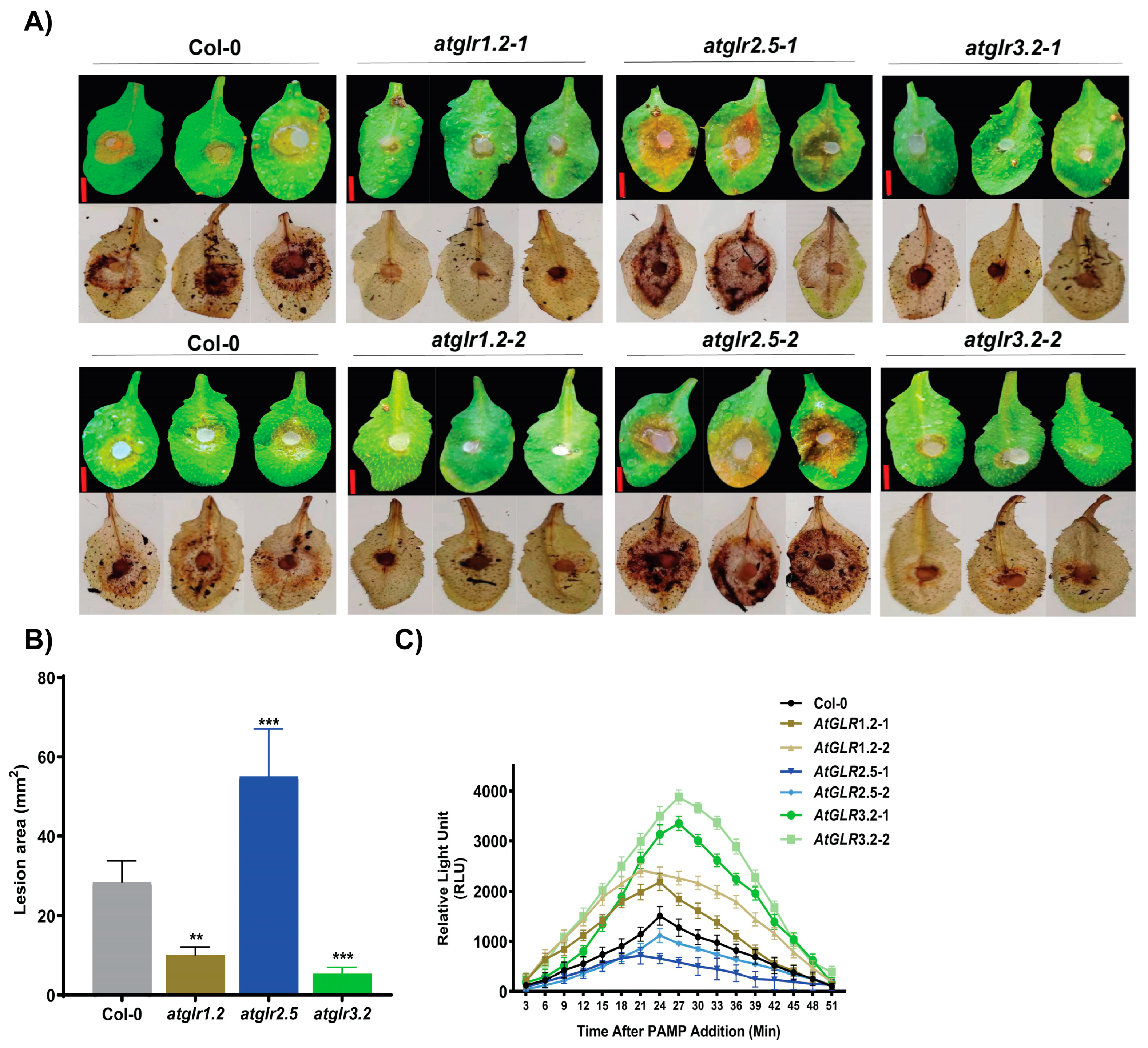
| Protein | Accession | Protein Size (aa) | Localization | Exon/Intron | Mol. Weight (Da) | Chromosomal Position | Isoelectric Point (pI) | Domains | |
|---|---|---|---|---|---|---|---|---|---|
| SMART Database | CDD Database | ||||||||
| BnGLR1 | XP_013666141.1 | 643 | Plasma membrane | 5/4 | 72,014 | ChrC09 | 9.26 | 3TMD, 3LCR | PBP1, PBP2 |
| BnGLR2 | XP_013666200.1 | 644 | Plasma membrane | 5/4 | 72,135 | ChrA10 | 9.44 | 3TMD, 2LCR | PBP1, PBP2 |
| BnGLR3 | XP_013720491.1 | 644 | Plasma membrane | 5/4 | 72,155 | ChrA10 | 9.44 | 3TMD, 2LCR | PBP1, PBP2 |
| BnGLR4 | XP_013666142.1 | 656 | Plasma membrane | 5/4 | 73,622 | ChrCnn_random | 9.59 | 3TMD, 2LCR | PBP1, PBP2 |
| BnGLR5 | XP_013660587.1 | 802 | Plasma membrane | 5/4 | 89,788 | ChrA01 | 7.69 | 4TMD, 2LCR | PBP1, PBP2 |
| BnGLR6 | XP_013745308.1 | 795 | Plasma membrane | 6/5 | 89,191 | ChrC01 | 7.04 | 4TMD | PBP1, PBP2 |
| BnGLR7 | XP_013700213.1 | 833 | Plasma membrane | 6/5 | 93,803 | ChrC01 | 6.34 | 4TMD, 3LCR | PBP1_GABAb_receptor_plant, PBP2 |
| BnGLR8 | XP_013724384.1 | 859 | Plasma membrane | 5/4 | 96,549 | ChrC09 | 6.21 | 5TMD, 1LCR | PBP1_GABAb_receptor_plant, Glur_Plant |
| BnGLR9 | XP_013660762.1 | 869 | Plasma membrane | 5/4 | 98,155 | ChrA09 | 7.64 | 4TMD, 2LCR | PBPI, Glur_Plant |
| BnGLR10 | XP_013724386.1 | 845 | Plasma membrane | 6/5 | 94,723 | ChrC09 | 6.34 | 5TMD, 1LCR | PBP1_GABAb_receptor_plant, PBP2 |
| BnGLR11 | XP_013660763.1 | 846 | Plasma membrane | 5/4 | 94,693 | ChrC09 | 6.57 | 4TMD, 1LCR | PBP1_GABAb_receptor_plant, PBP2 |
| BnGLR12 | XP_013663332.1 | 874 | Plasma membrane | 4/3 | 97,865 | ChrA06 | 8.41 | 3TMD, 3LCR | PBP1_GABAb_receptor_plant, PBP2 |
| BnGLR13 | XP_013644299.1 | 873 | Plasma membrane | 4/3 | 97,979 | ChrC07 | 8.68 | 5TMD, 1LCR | PBP1_GABAb_receptor_plant, PBP2 |
| BnGLR14 | XP_013674287.1 | 867 | Plasma membrane | 5/4 | 97,316 | ChrC02 | 7.65 | 5TMD, 2LCR | PBP1_GABAb_receptor_plant, PBP2 |
| BnGLR15 | XP_022564985.1 | 867 | Plasma membrane | 5/4 | 97,481 | ChrC02 | 6.79 | 6TMD, 1LCR | PBP1_GABAb_receptor_plant, PBP2 |
| BnGLR16 | XP_013721387.1 | 855 | Plasma membrane | 5/4 | 96,045 | ChrA02 | 6.99 | 6TMD, 1LCR | PBP1_GABAb_receptor_plant, PBP2 |
| BnGLR17 | XP_013675190.1 | 866 | Plasma membrane | 5/4 | 97,047 | ChrA02 | 8.06 | 6TMD, 2LCR | PBP1_GABAb_receptor_plant, PBP2 |
| BnGLR18 | XP_013721377.1 | 873 | Plasma membrane | 5/4 | 98,377 | ChrC02 | 6.21 | 3TMD, 2LCR | PBP1_GABAb_receptor_plant, PBP2 |
| BnGLR19 | XP_013677704.1 | 873 | Plasma membrane | 5/4 | 97,852 | ChrC02 | 6.13 | 3TMD, 1LCR | PBP1_GABAb_receptor_plant, PBP2 |
| BnGLR20 | XP_013716662.2 | 867 | Plasma membrane | 5/4 | 97,436 | ChrA03 | 6.93 | 2TMD, 2LCR, 1PBPe | PBP1_GABAb_receptor_plant, Glur_Plant, PBP2 |
| BnGLR21 | XP_013739323.1 | 840 | Plasma membrane | 7/6 | 94,418 | ChrC03 | 8.37 | 1TMD, 1B3 | PBP1_GABAb_receptor_plant, Glur_Plant, B3, PBP2 |
| BnGLR22 | XP_022574381.1 | 912 | Plasma membrane | 7/6 | 102,694 | ChrA04 | 7.13 | 1TMD, 2LCR, 1PBPe | PBP1_GABAb_receptor_plant, Glur_Plant |
| BnGLR23 | XP_013745928.1 | 585 | Plasma membrane | 4/3 | 66,027 | ChrA04 | 8.76 | 2TMD, 1PBPe | Glur_Plant, PBP1, LGC |
| BnGLR24 | XP_022545808.1 | 959 | Plasma membrane | 5/4 | 107,726 | ChrA05 | 8.69 | 2TMD, 1PBPe | PBP1_GABAb_receptor_plant, Glur_Plant |
| BnGLR25 | XP_013687288.1 | 956 | Plasma membrane | 5/4 | 108,094 | ChrA04 | 8.53 | 2TMD, 2LCR, 1PBPe | PBP1_GABAb_receptor_plant, Glur_Plant |
| BnGLR26 | XP_013744174.1 | 957 | Plasma membrane | 5/4 | 108,035 | ChrA04 | 7.90 | 2TMD, 1LCR, 1PBPe | PBP1_GABAb_receptor_plant, Glur_Plant |
| BnGLR27 | XP_013744172.1 | 925 | Plasma membrane | 5/4 | 104,404 | ChrA04 | 6.81 | 2TMD, 2LCR, 1PBPe | PBP1_GABAb_receptor_plant, Glur_Plant |
| BnGLR28 | XP_013744173.2 | 922 | Plasma membrane | 5/4 | 102,918 | ChrA04 | 8.15 | 2TMD, 1PBPe | PBP1_GABAb_receptor_plant, Glur_Plant |
| BnGLR30 | XP_013746034.1 | 659 | Plasma membrane | 4/3 | 74,709 | ChrC04 | 5.89 | 4TMD | PBP1, LGC, Glur_Plant |
| BnGLR31 | XP_022557020.1 | 946 | Plasma membrane | 5/4 | 106,999 | ChrC04 | 6.19 | 2TMD, 1PBPe | PBP1_GABAb_receptor_plant, Glur_Plant |
| BnGLR32 | XP_013746035.1 | 880 | Plasma membrane | 6/5 | 99,879 | ChrC04 | 6.24 | 1TMD, 1PBPe | PBP1_GABAb_receptor_plant, Glur_Plant |
| BnGLR33 | XP_013721832.1 | 946 | Plasma membrane | 5/4 | 106,780 | ChrC04 | 6.12 | 2TMD, 1PBPe | PBP1_GABAb_receptor_plant, Glur_Plant |
| BnGLR34 | XP_013699507.1 | 997 | Plasma membrane | 6/5 | 112,457 | ChrAnn_randm | 8.94 | 2TMD, 2LCR, 1PBPe | PBP1_GABAb_receptor_plant, Glur_Plant |
| BnGLR35 | XP_013717843.1 | 947 | Plasma membrane | 6/7 | 106,852 | ChrC09 | 9.06 | 2TMD, 1PBPe | PBP1_GABAb_receptor_plant, Glur_Plant |
| BnGLR36 | XP_013678599.1 | 914 | Plasma membrane | 5/4 | 103,158 | ChrC02 | 6.09 | 3TMD, 3LCR | PBP1_GABAb_receptor_plant, Glur_Plant, LGC |
| BnGLR37 | XP_013701564.1 | 921 | Plasma membrane | 6/5 | 103,095 | ChrA08 | 8.57 | 1TMD, 2LCR, 1PBPe | PBP1_GABAb_receptor_plant, Glur_Plant |
| BnGLR38 | XP_022545804.1 | 929 | Plasma membrane | 7/6 | 103,972 | ChrA08 | 8.57 | 1TMD, 2LCR, 1PBPe | PBP1_GABAb_receptor_plant, Glur_Plant |
| BnGLR39 | XP_013656439.1 | 929 | Plasma membrane | 8/7 | 103,924 | ChrA08 | 8.57 | 1TMD, 2LCR, 1PBPe | PBP1_GABAb_receptor_plant, Glur_Plant |
| BnGLR40 | XP_013666559.1 | 952 | Plasma membrane | 6/5 | 106,246 | ChrA10 | 8.34 | 1TDM, 2LCR, 1PBPe | PBP1_GABAb_receptor_plant, PBP2, LGC |
| BnGLR41 | XP_013696828.1 | 952 | Plasma membrane | 5/4 | 106,246 | ChrC05 | 7.94 | 2TMD, 2LCR, 1PBPe | PBP1_GABAb_receptor_plant, PBP2, LGC |
| BnGLR42 | XP_013664803.1 | 884 | Plasma membrane | 6/5 | 99,044 | ChrA09 | 6.36 | 1TDM, 1LCR, 1PBPe | PBP1_GABAb_receptor_plant, PBP2, LGC |
| BnGLR43 | XP_013737627.1 | 894 | Plasma membrane | 6/5 | 100,672 | ChrC04 | 6.44 | 1TDM, 2LCR, 1PBPe | PBP1_GABAb_receptor_plant, PBP2 |
| BnGLR44 | XP_013737625.1 | 952 | Plasma membrane | 6/5 | 106,516 | ChrC04 | 7.16 | 1TMD, 2LCR, 1PBPe | PBP1_GABAb_receptor_plant, PBP2 |
| BnGLR45 | XP_013748685.1 | 945 | Plasma membrane | 6/5 | 105,775 | ChrA10 | 7.56 | 2TMD, 3LCR, 1PBPe | PBP1_GABAb_receptor_plant, Glur_Plant |
| BnGLR46 | XP_013683371.1 | 944 | Plasma membrane | 6/5 | 105,706 | ChrC05 | 6.33 | 1TMD, 3LCR, 1PBPe | PBP1_GABAb_receptor_plant, Glur_Plant |
| BnGLR47 | XP_013683372.1 | 886 | Plasma membrane | 6/5 | 99,953 | ChrC03 | 6.10 | 1TDM, 2LCR, 1PBPe | PBP1_GABAb_receptor_plant, Glur_Plant |
| BnGLR48 | XP_013734086.1 | 885 | Plasma membrane | 6/5 | 99,802 | ChrA07 | 6.48 | 1TDM, 2LCR, 1PBPe | PBP1_GABAb_receptor_plant, Glur_Plant |
| BnGLR49 | XP_013734084.1 | 943 | Plasma membrane | 6/5 | 105,585 | ChrC05 | 6.89 | 1TMD, 3LCR, 1PBPe | PBP1_GABAb_receptor_plant, Glur_Plant |
| BnGLR50 | XP_013727017.1 | 912 | Plasma membrane | 5/4 | 101,668 | ChrA07 | 7.97 | 1TDM, 1LCR, 1PBPe | PBP1_GABAb_receptor_plant, Glur_Plant, LGC |
| BnGLR51 | XP_013692909.1 | 912 | Plasma membrane | 5/4 | 101,543 | ChrC07 | 7.26 | 1TMD, 2LCR, 1PBPe | PBP1_GABAb_receptor_plant, Glur_Plant, LGC |
| BnGLR52 | XP_013751706.1 | 913 | Plasma membrane | 7/6 | 101,458 | ChrC01 | 8.54 | 1 TMD, 1PBPe | PBP1, GABAb_receptor_plant, Glur_Plant |
| BnGLR53 | XP_013670580.1 | 912 | Plasma membrane | 7/6 | 101,572 | ChrC01 | 8.55 | 1 TMD, 1PBPe | PBP1_GABAb_receptor_plant, Glur_Plant, LGC |
| BnGLR54 | XP_013663029.1 | 891 | Plasma membrane | 7/6 | 99,380 | ChrC08 | 8.77 | 1TMD, 1LCR, 1PBPe | PBP1_GABAb_receptor_plant, Glur_Plant |
| BnGLR55 | XP_013663027.1 | 906 | Plasma membrane | 7/6 | 100,844 | ChrC08 | 8.53 | 1TMD, 1LCR, 1PBPe | PBP1_GABAb_receptor_plant, Glur_Plant |
| BnGLR56 | XP_013662917.1 | 891 | Plasma membrane | 7/6 | 99,338 | ChrA09 | 8.65 | 1TDM, 1LCR, 1PBPe | PBP1_GABAb_receptor_plant, Glur_Plant |
| BnGLR57 | XP_013734089.1 | 921 | Plasma membrane | 7/6 | 103,167 | ChrA03 | 8.76 | 1TMD, 1LCR, 1PBPe | PBP1_GABAb_receptor_plant, Glur_Plant |
| BnGLR58 | XP_013683373.1 | 921 | Plasma membrane | 7/6 | 102,816 | ChrC03 | 8.60 | 1TMD, 1LCR, 1PBPe | PBP1_GABAb_receptor_plant, Glur_Plant |
| BnGLR59 | XP_022557765.1 | 1068 | Plasma membrane | 8/7 | 120,615 | ChrC09 | 8.90 | 1TMD, 1PBPe | PBP1, Glur_Plant |
| BnGLR60 | XP_013737629.1 | 921 | Plasma membrane | 8/7 | 102,807 | ChrC04 | 7.95 | 1TMD, 2LCR, 1PBPe | PBP1_GABAb_receptor_plant, Glur_Plant |
| BnGLR61 | XP_013737628.1 | 928 | Plasma membrane | 8/7 | 103,572 | ChrC04 | 8.18 | 1TMD, f2LCR, 1PBPe | PBP1_GABAb_receptor_plant, Glur_Plant |
Disclaimer/Publisher’s Note: The statements, opinions and data contained in all publications are solely those of the individual author(s) and contributor(s) and not of MDPI and/or the editor(s). MDPI and/or the editor(s) disclaim responsibility for any injury to people or property resulting from any ideas, methods, instructions or products referred to in the content. |
© 2024 by the authors. Licensee MDPI, Basel, Switzerland. This article is an open access article distributed under the terms and conditions of the Creative Commons Attribution (CC BY) license (https://creativecommons.org/licenses/by/4.0/).
Share and Cite
Gulzar, R.M.A.; Ren, C.-X.; Fang, X.; Xu, Y.-P.; Saand, M.A.; Cai, X.-Z. Glutamate Receptor-like (GLR) Family in Brassica napus: Genome-Wide Identification and Functional Analysis in Resistance to Sclerotinia sclerotiorum. Int. J. Mol. Sci. 2024, 25, 5670. https://doi.org/10.3390/ijms25115670
Gulzar RMA, Ren C-X, Fang X, Xu Y-P, Saand MA, Cai X-Z. Glutamate Receptor-like (GLR) Family in Brassica napus: Genome-Wide Identification and Functional Analysis in Resistance to Sclerotinia sclerotiorum. International Journal of Molecular Sciences. 2024; 25(11):5670. https://doi.org/10.3390/ijms25115670
Chicago/Turabian StyleGulzar, Rana Muhammad Amir, Chun-Xiu Ren, Xi Fang, You-Ping Xu, Mumtaz Ali Saand, and Xin-Zhong Cai. 2024. "Glutamate Receptor-like (GLR) Family in Brassica napus: Genome-Wide Identification and Functional Analysis in Resistance to Sclerotinia sclerotiorum" International Journal of Molecular Sciences 25, no. 11: 5670. https://doi.org/10.3390/ijms25115670






